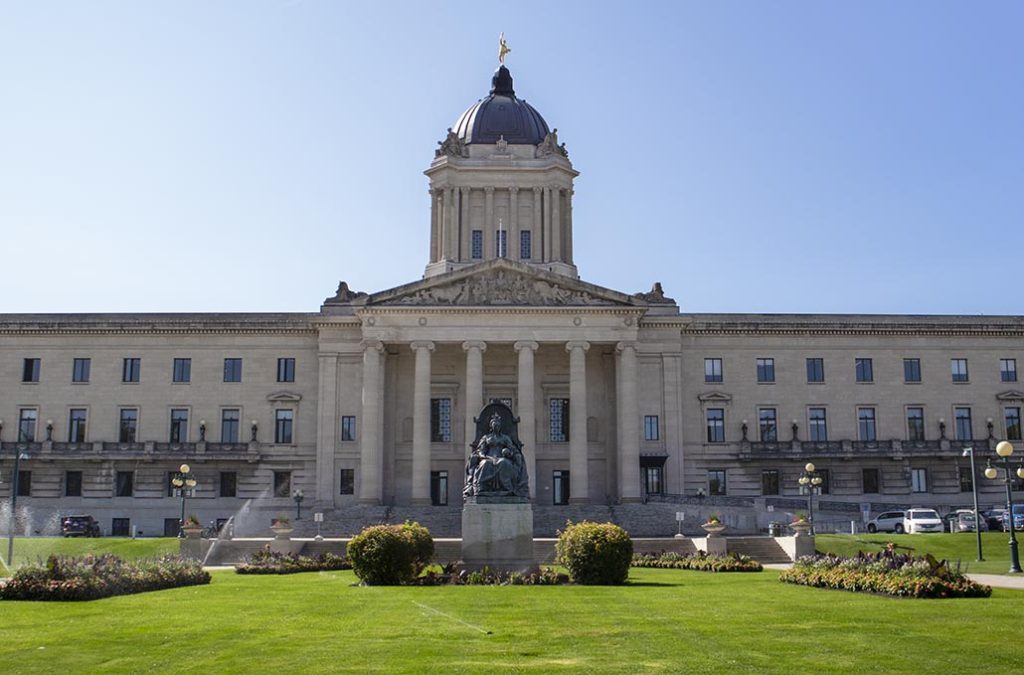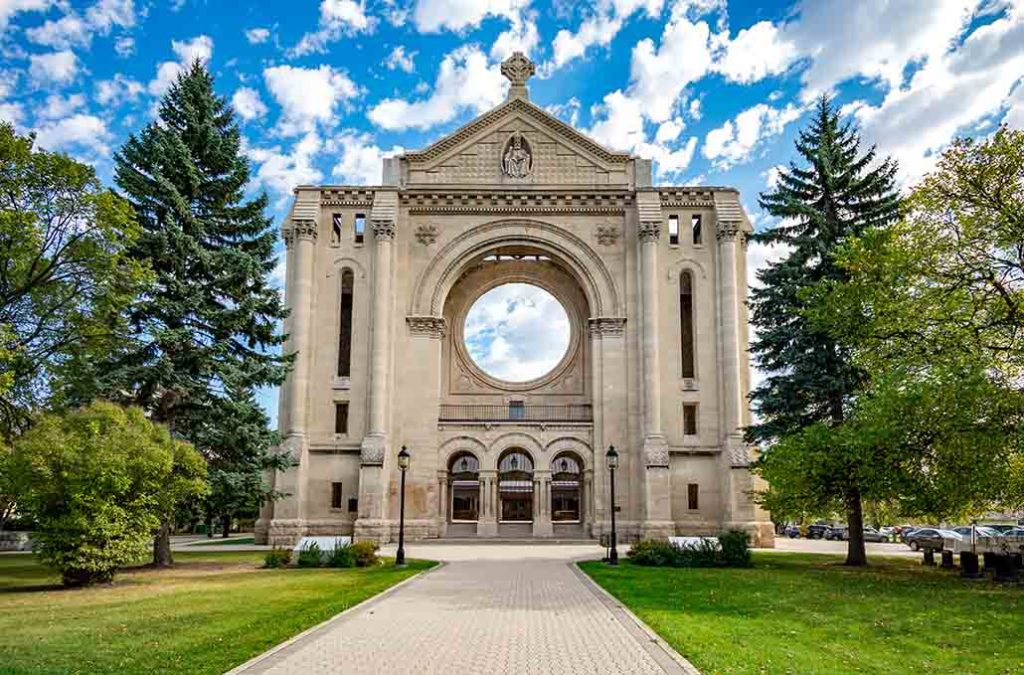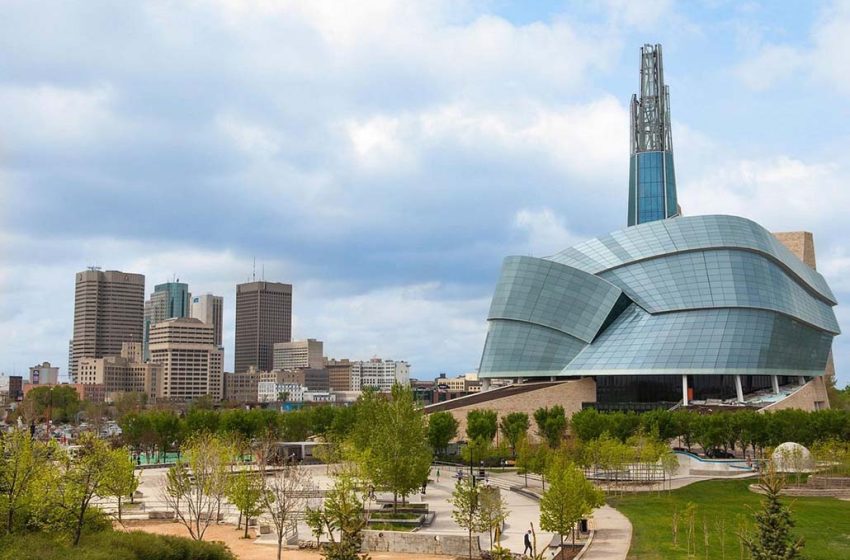—— A Journey of Memory and Beauty in the Heart of the Canadian Prairies
Located in the province of Manitoba, Canada, Winnipeg is known as the “Heart of the Prairies.” This city is not only a transportation hub between Eastern and Western Canada, but also a cultural center where art and history intertwine. From the stories of Indigenous peoples to the chapters of immigration and pioneering, from avant-garde modern art to memorializing historical scars, Winnipeg’s landmark buildings serve as mirrors reflecting the deep and moving soul of this city. Today, I’ll take you on a tour of Winnipeg’s five must-see art and history landmarks—not just tourist attractions, but keys to understanding the city’s rich history and culture.
1. Canadian Museum for Human Rights
Landmark Significance: Canada’s first national museum outside of the national capital, exploring global and national human rights issues
As you walk into Winnipeg’s downtown Forks area, a striking building made of glass and stone, resembling a mountain peak, catches your eye. This is the internationally renowned Canadian Museum for Human Rights. Since its opening in 2014, the museum has become one of Winnipeg’s soul symbols.
The building itself is a work of art, designed by the world-famous architect Antoine Predock. The design was inspired by the stone piles of the prairies and the image of light breaking through dark clouds. Inside, visitors start from the dark basalt “cave” at the bottom and ascend through a series of pathways representing human rights, ultimately reaching the “Tower of Light” – symbolizing the human journey from suffering to hope.
The exhibits are extensive, covering historical events such as the Holocaust, apartheid in South Africa, Indigenous residential schools, as well as contemporary issues like women’s rights, LGBTQ+ rights, and media freedom. The museum places special emphasis on interactive experiences, allowing visitors to engage with the exhibits through touchscreens, audio interviews, and immersive video theaters.
Notable Exhibits:
- “The Journey for Human Rights” route: a timeline running throughout the museum, from ancient to contemporary human rights issues.
- “The Voices of Indigenous Peoples” exhibition: showcasing the struggles for cultural identity and land rights of Canada’s Indigenous peoples.
- “The History of Human Rights in Canada”: tracing the origins and development of the Canadian Charter of Rights and Freedoms.
Travel Tips:
- Admission is approximately CAD 18 for adults, with discounts for students and families.
- It is recommended to allocate at least 3 hours for a visit.
- The museum’s Cloud Bistro offers prairie-inspired dishes with a view of the Forks area.
2. Manitoba Legislative Building
Landmark Significance: The center of government and a place filled with mysterious symbols, blending classical architectural aesthetics with occult imagery
At the end of Broadway, Winnipeg’s grandest historic building, the Manitoba Legislative Building, stands tall. Completed in 1920, this building follows the Greek Revival architectural style, with its grand entrance supported by massive Corinthian columns. On top of its dome stands the famous “Golden Boy” statue, symbolizing youth, agriculture, and progress.
What truly fascinates visitors, however, is that this building is considered one of Canada’s most mysterious. Historian Frank Albo discovered that the entire building is filled with hidden symbols related to Freemasonry, Egyptian mysticism, and the golden ratio. His research led to the publication of The Hermetic Code and sparked a “mystery tour” trend.

By taking a guided tour, you will uncover:
- The “Double Lions” at the grand marble hall’s entrance, symbolizing power and the sacred.
- The “Echo Point” in the central rotunda, where footsteps cause mysterious echoes.
- Hidden golden ratio patterns in the building’s dimensions and sculpture arrangements.
Guided Tour Recommendations:
- Participate in “The Hermetic Code Tour” (held multiple times weekly, approximately CAD 40), where an expert will explain the hidden designs and historical references.
- The free open tours also offer insight into Manitoba’s political system and the building’s interior.
Travel Tips:
- The nearby gardens and lawns are perfect photo spots, especially in spring and summer.
- You can also visit the “Assiniboine Park” and the “Metropolitan Theatre” to round out your itinerary.
3. Winnipeg Art Gallery and Qaumajuq Museum
Landmark Significance: The world’s largest collection of Inuit art, blending local and global artistic perspectives
The Winnipeg Art Gallery (WAG), founded in 1912, is one of the oldest public art galleries in Canada. In 2021, WAG expanded with the opening of the Qaumajuq Museum, named after the Inuit word meaning “it gives off light.” This new wing is dedicated to showcasing the art of the Inuit and other Arctic Indigenous peoples.
With a collection of over 14,000 pieces of Inuit artwork, Qaumajuq is the largest collection of its kind in the world. The works range from traditional sculptures, lithographs, and fur art to contemporary multimedia creations. These artworks not only reflect the survival wisdom and worldview of the Arctic peoples but also help the global audience gain a deeper understanding of Inuit culture’s contemporary relevance.
Exhibition Highlights:
- “The Visible Vault”: a four-story transparent wall displaying hundreds of Inuit sculptures.
- “INUA Exhibition”: curated by four Indigenous curators, reflecting the thoughts of Northern contemporary artists on identity, environment, and the future.
- The Local Art Section: showcases the works of contemporary artists and community creations from Manitoba.
Travel Tips:
- Admission is about CAD 18 for adults, with free entry after 5:00 PM on Fridays.
- The museum has a café and bookstore worth exploring.
- They also host “Family Interactive Days” and “Arctic Film Nights,” which are great for visiting with children.
4. The Forks National Historic Site
Landmark Significance: A 6,000-year-old meeting place for humans, the birthplace of Winnipeg’s history
If you are looking for the heart of Winnipeg, it would undoubtedly be The Forks. Located at the confluence of the Red and Assiniboine rivers, this area has been a gathering and trading hub for Indigenous peoples for over 6,000 years. Today, The Forks is not only a leisure area for locals but also a national historic site.
The entire area has been meticulously planned, combining historical architecture, art installations, outdoor activities, and local food culture:
- Visit The Forks Market, a former railway warehouse now filled with local food vendors, artisanal shops, and art exhibitions.
- Take a stroll through the “Peace Garden” and the “Oodena Art Installation,” which reflect Indigenous perspectives on nature and peace.
- Walk across the “Esplanade Riel Pedestrian Bridge,” which connects The Forks to St. Boniface and offers stunning views, especially at sunset.
What makes The Forks special is that it doesn’t just preserve history but brings it to life. Every summer, the area hosts Indigenous festivals, historical reenactments, outdoor movies, and music festivals, offering visitors a chance to experience different eras.
Travel Tips:
- The best time to visit is between May and September to experience the outdoor market and street performances.
- In winter, you can skate on the “Red River Ice Trail,” which stretches over 8 kilometers, making it one of the longest natural ice rinks in the world.
- You can also take a “River Spirit River Tour” for about CAD 20 to explore the area by boat.
5. St. Boniface Cathedral Ruins and French Quarter
Landmark Significance: A symbol of Francophone Canadian culture, the “Left Bank” of Winnipeg

Crossing the Esplanade Riel Pedestrian Bridge, you will enter Winnipeg’s “Left Bank”—the St. Boniface area, the most vibrant Francophone part of the city and a key witness to the history of missionary work and immigration. The St. Boniface Cathedral ruins, originally built in 1908, were destroyed by fire in 1968. The preserved stone façade remains an imposing and eternal monument.
Behind the ruins stands the present St. Boniface Cathedral, where the first archbishop of Manitoba is buried. The most notable grave in the cemetery is that of Louis Riel, a Métis leader and one of Canada’s most controversial yet revered national heroes.
St. Boniface is not just a religious center; it is also the heart of French-Canadian culture, theater, and literature:
- The St. Boniface Museum (Maison Riel) exhibits artifacts of Louis Riel, Métis craftsmanship, and immigration history.
- The French bookstores and street art highlight the vitality of Winnipeg’s bilingual culture.
- The annual “Festival du Voyageur” winter celebration in February features French music, food, and folk activities.
Travel Tips:
- In summer, take the “St. Boniface Ghost Tour” to explore the mysterious stories of this ancient district.
- French-speaking tours can be arranged in advance, but it’s helpful to know basic French or use a translation app.
- Nearby cafes like Café Postal and La Belle Baguette are perfect for a photo opportunity or a relaxing break.
Explore the Soul of Winnipeg Through Its Landmarks
The art and historical landmarks in Winnipeg are not just cold buildings; they are containers of the city’s memory, and cultural crossroads. From the footprints of Indigenous peoples at The Forks to the Northern lights of the art gallery, from the mysterious halls of the Legislative Building to the Tower of Light in the Museum for Human Rights, every landmark tells the story of Winnipeg’s past and present. If you dedicate a day or two to visit them, you’ll find a unique connection to this dynamic Canadian city.

